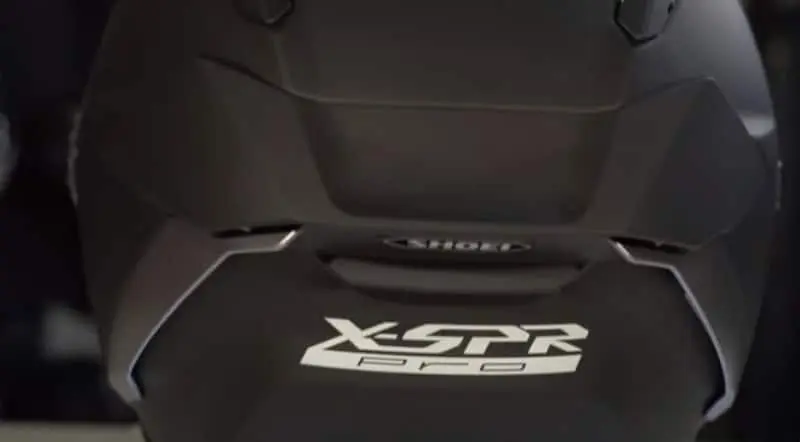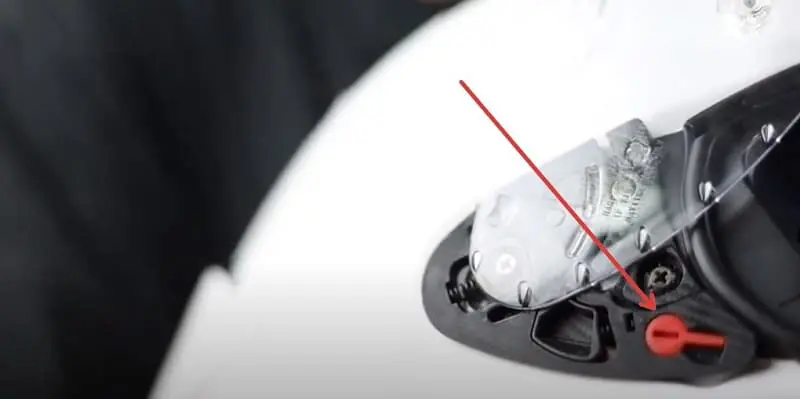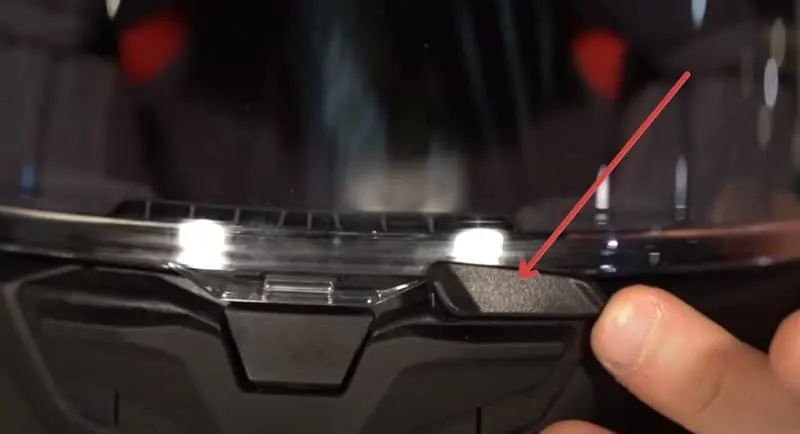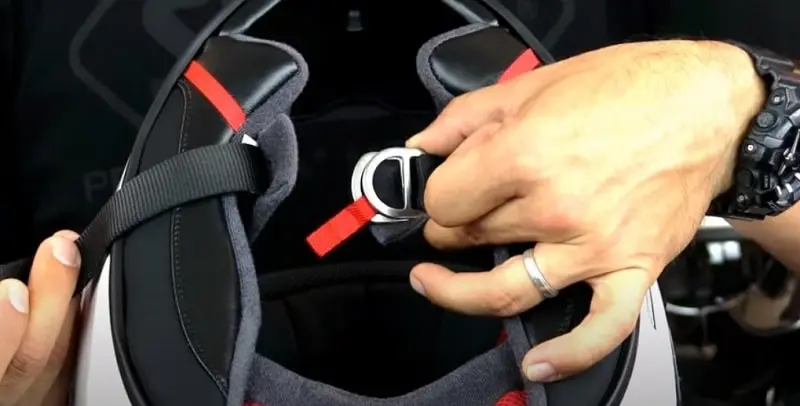To be honest with you, when I first saw this, I didn’t like it. I saw it in the pictures and didn’t rate it at all.
I thought to myself, what have they done? That is not a better-looking helmet, but to be honest, it looks fantastic now that I’ve seen it in the flesh.
It’s a lot of money for a helmet, and everything is getting more expensive, so it’s expected that the latest model will become more expensive.
After all, we are looking at one of the top premium brands available today.

Shoei X SPR Pro Review
Table of Contents
Shell Construction
The shell for this helmet is made from the same AIM plus material as the X-Spirit 3, a composite of different fibers to deliver the right blend of protection and lightweight.
Weight
We weighed this helmet in size medium on our scales at 1479 grams/3.2 lbs which are 72 grams more than an X-Spirit 3 when we weighed it last year.
But, I think anyone would be hard pushed to say they can feel the extra 72 grams of weight.
The X-SPR Pro is approved to the new 2206 standard for the road, making this the second Shoei with that approval after the NXR 2.
The FIM also approves it for use in international racing and Shoei’s MotoGP. As a result, the main sponsored riders at the TT have already been wearing it at those events.
The FIM approval might explain the marginal extra weight, as this is a remarkably stiff helmet for protection in those higher speed impacts that racers often have to deal with.

Venting
Venting on a race helmet is crucial. The main chin vent on this helmet allows air through the top of the chimney to the eye port.
The secondary chin vent allows air to flow through the holes behind the cheek pads to the cheeks.
When I’m riding, I can hear air flowing through the vents, and it’s directed to the visor itself rather than directly at your face.
You don’t feel it as chilly as you might in other helmets. This is about lowering the temperature inside the helmet rather than giving you an icy blast of air.
Up top, there are three switches. The main one sits in the center, revealing two inlets coming down to the interior.
If the airflow gets too strong, the slider can be put halfway across so you only uncover half of the inlet.
The other two switches sit on either side of the main vent, and each exposes a hole that comes down inside the helmet.
I find the central one easiest to use. The two on the sides are a little fiddlier, but it’s not too bad when you’re riding along with gloves.
And anyway, this is a race helmet; realistically, a racer will set those vents up before the start and then leave them like that during the race.
You don’t tend to see someone hammering down the main straight with their left hand in the air trying to open a vent.
As for getting the air out again, it relies on the principle of hot air rising. So, cool air flows through the channels on top of the lid.
It then escapes through ten holes in the polystyrene impact liner that allow the warm air to be drawn up.
Air then gets into the scoop and is drawn away through four outlets on the channels.
You get two on each side, and then there are also exhaust vents that run directly from the back of the lid to the outlets just inside the air stabilizer.
The aerodynamics are a big part of the story with the X-SPR Pro, but I’ll get onto those later.
Visor
One of the changes that will be most obvious for riders who are switching from a spirit 3 to this helmet is the visor. It mounts in the same way, but it’s flatter to make it more suitable for visor tear-offs.
There’s also an extra element of security to stop the visor from coming off in an impact. I think it is part of that FIM racing approval I mentioned earlier.
If you flick the red lever on the base plate towards the bottom of the helmet, it disables the release lever for the visor helping it stay in place when it’s most needed in a crash.
If you’re getting frustrated and wondering why your visor won’t come off when you’re trying to change it, check that that lever’s in the right place. It needs to be raised rather than lowered.

The visor lowers in five stages. First, from fully open until it touches the bottom seal, you push it down to semi-lock it on a lip under the visor ledge.
To fully lock it, the tab then slides over, stopping the lifting part from being able to lift the visor.
To release the lock, slide that tab back out of the way and then push the section underneath the lip to release the half lock.

I found that a bit fiddly, especially when I first started wearing this lid, but quite a few helmets now have an arrangement similar to that, and you get used to it after a little use.
The sliding lock tab has a second function as well. If you slide it towards the center of the lid before lowering the visor, it will block off the last few millimeters of travel.
This gives you a little bit of airflow to the inside, which can be very welcome on a warm day.
On the outside of the visor, you get posts for the tear-offs I mentioned earlier, and on the inside, you get the pin lock pins.

Pinklock Anti Fogging
The pin lock insert is included in the box with this helmet, and it’s a pinlock EVO. To anyone else, that’s a pinlock 120, but Shoei calls it a Pinlock Evo for some reason.
Either way, it’s the highest grade of protection against mist that you can get.
The visor retains the vortex generators on each side designed to push air away from that part of the helmet and stop the lid from getting too noisy.
Noise Levels
I wouldn’t normally comment on noise, but I will break that rule on this occasion. This isn’t the noisiest helmet I’ve worn, not by any stretch of the imagination, nor is it the quietest.
The noise you experience will always depend on how a helmet works in your particular conditions. Things like the bike you ride, the kit you wear, your riding style, and many other factors.
But I will say that expecting a race helmet like this to be quiet is a bit like expecting a Ducati Panigale to be comfortable.
You might find this quiet just as you might find a Panigale comfortable, but Shoei wouldn’t have had a quiet ride on their check sheet for the X-SPR Pro because it’s not a high priority for racers.
If the noise level is a big priority, you’re taking a gamble if you buy a race lid like this.
Interior

The lining material is pretty familiar and almost identical to the X-Spirit 3.
There’s a softer brushed fabric where the helmet drags over your face. Also, there’s a lighter material around the top of the head.
The cheek pads can be swapped out for different sizes to adjust the fit.
Although, the standard thickness in most sizes is 35 millimeters, and you can go down to 31 millimeters for a bit more room.
There are also three thicker sizes available if you want a closer fit.
The cheek pads can also be put into race mode, which tilts the helmet back on your head to give you better forward vision when you’re in a racing tuck.
On the X-Spirit 3, you could do that without taking the pads out of the helmet, but on this one, you need to remove them, relocate some poppers and then put them back in the helmet in race mode.
The top pad is also adjustable, and the options for that are vast. In addition, there are four removable sections to that top pad, front back, and two temple pads.
You can also tweak how they all mount into the holder, which adjusts the fit slightly.
Each of those pads also forms a pocket, which lets you put an extra piece of padding in there to give extra support around the head.
You can do the same on the very top of the head. So if you want the fit to be just so, then there are all sorts of combinations you can try to get it right for you.
As well as removable cheek and head pads, the covers for the chin strap come out for washing.
If you doubted this for even a fraction of a millisecond, the strap does that with D-rings as you get on all good race helmets.
Bluetooth
Behind the cheek pads, there are recesses for intercom speakers. A pair of center speakers sit in there perfectly.
A pair of 40-millimeter Cardo speakers will also sit there, but they end up sitting slightly proud of the recess.
There’s enough room on the shell as well for the comms module. I’d suggest using a self-adhesive mount as I wouldn’t say I like the way the clamp mounts slot between the shell and the impact liner.
The lever, the shell, and the EPS are away from each other, and it’s not a particularly tidy solution.
Hydration Pack
Another new addition for the X SPR Pro is a recess right in front of the mouth where you can clip in the tube and the bite valve for a hydration pack.
Shoei says they’ll be adding a specific accessory part for a hydration pack somewhere along the line, and that will be designed to work with this helmet.

Accessories
There will be some additional parts in the box. For example, you might find the breath guard in the box rather than pre-installed, and then you have a choice of two parts for the base of the chin bar.
The lower air spoiler deflects air away from the chin, or there’s an optional chin curtain that isolates you from the cold air as it flows around the base of the helmet.
Safety Standards
This helmet is approved for the new ECE 2206 standard for the road and by the FIM for international racing.
It’s too early to say that this helmet’s ACU gold is for UK track use, but if it doesn’t get that gold stamp.
It’s the same story with the UK government’s Sharp impact tests . They are never done until the helmet goes on general sale, so we don’t know what rating it will get yet.
. They are never done until the helmet goes on general sale, so we don’t know what rating it will get yet.
But the last two experts both notched up five-star ratings from Sharp, and if this one doesn’t get the same, then I’ll be staggered.
Sizing
Sizing this lid comes in sizes from extra small to double extra large. In addition, there are four shell sizes to cover that range.
Helmet sizes extra small and small share the smallest of those four shelves. Next, medium and large get their shell, and then XL and double XL share the biggest shell.
In Conclusion
Everything about it feels well made and finished. The shell is a work of wonder, really, and it creates a reassuringly stiff construction.
The lining is very comfortable. It’s identical to the X Spirit 3, so if you’ve used one of those, you know exactly what you are getting.
Of course, you can tweak to your heart’s content, although, thankfully, the standard size felt like it had been custom-fitted for me.
The peripheral vision is superb, especially in the upward direction, which is most important when you want to look ahead in the tucked position.
The venting draws in a decent amount of cooling air though it’s designed to work best in a tucked racing position, so road riding will never get the best from that venting.
The approvals for the lid ECE 2206 and FIM are also the highest available.
Of course, there’s no way of knowing this for sure, especially without seeing the test results that no manufacturer will ever release, but I would say this has to be one of the safest helmets on the market.
Of course, all this is about what riding on the road is like rather than where the X SPR Pro is designed to be used on the track.
Where To Buy
| Model | Sports Bike Shop |
|---|---|
| Shoei X SPR Pro | From £699 |


